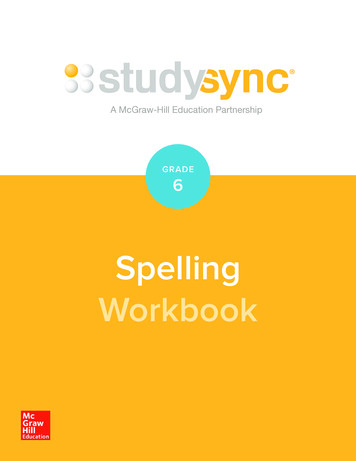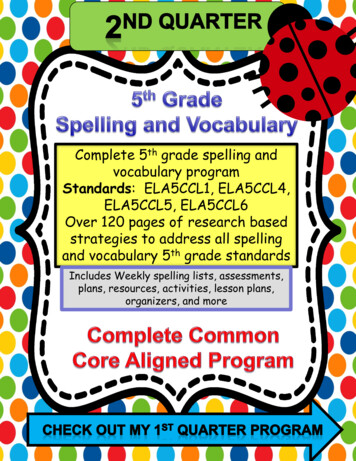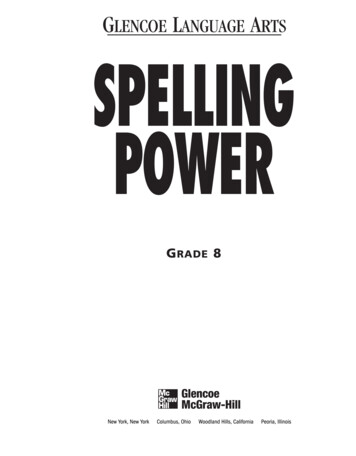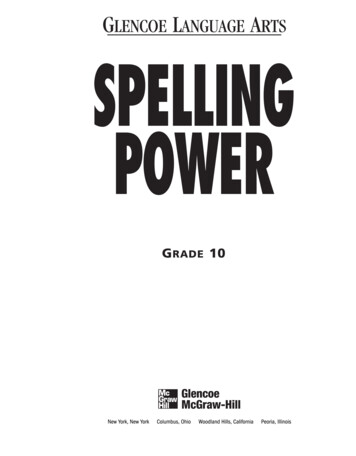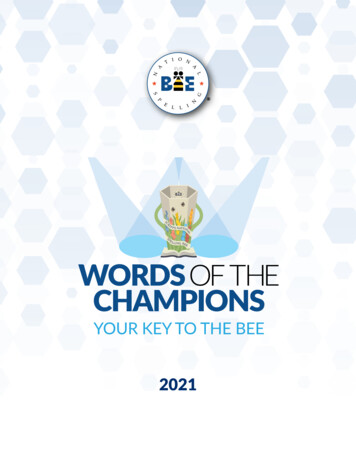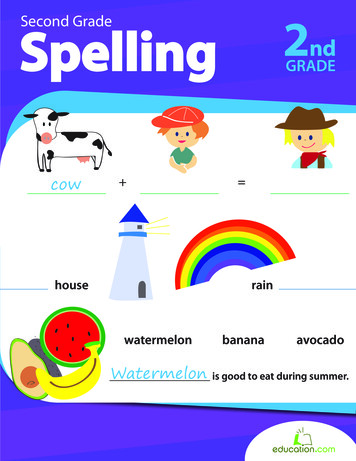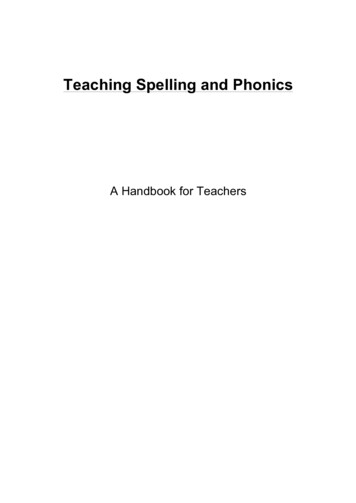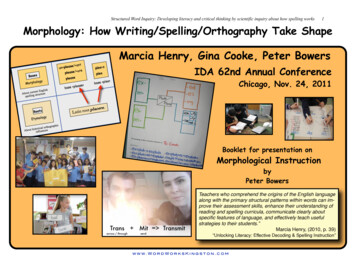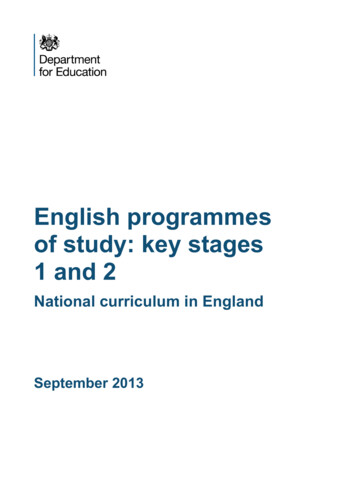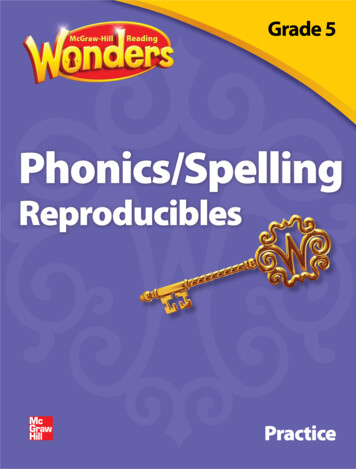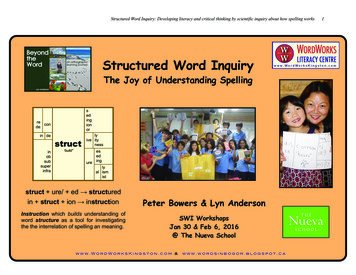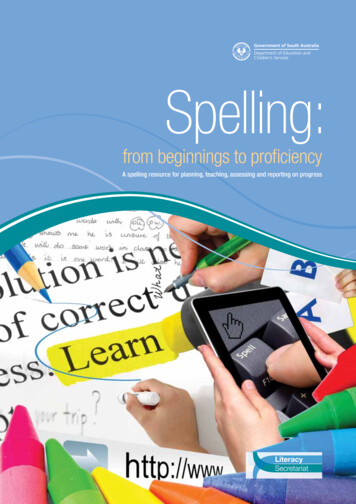
Transcription
Spelling:from beginnings to proficiencyA spelling resource for planning, teaching, assessing and reporting on progress
AcknowledgmentsBraeview Junior PrimaryPort Pirie West Primary SchoolRosie AntenucciIngrid AldertonDon BoeremaRos FryerJane LeakerCheryl McLeanMargaret SankeyJeannette Conroy 2011, The State of South Australia,Department of Education and Children’s Services[CIP data to be supplied]Produced by: Programs & Resources Early Years, Literacy Secretariat,Department of Education and Children’s ServicesDesigned by: She Creative Pty LtdPhotos: Shutterstock Images submitters. Used under license, no copyingof photographs permitted.
ContentsChapter 1: Teaching spelling: an overviewA changing systemLanguage acquisition, language learningLearning to spell is a multisensory processShared responsibility for spellingStandard Australian English spellingEssential components of a spelling programProblem-solving approachAllocation of timeProfiles of students5566777889Chapter 2: Spelling as a developmental processStages of spelling developmentMore than stages of development131315Chapter 3: The spelling system and spelling strategiesWritten language as a meaning-based social systemKnowledge about spellingMajor spelling strategies17171721Chapter 4: ProgrammingA quality spelling programSpelling within a coherent whole site literacy programProgrammingProgramming models: primaryProgramming models: secondary232323252640Chapter 5: Assessment, recording and reporting of spellingPrinciples of assessmentAssessment strategiesAssessment of learningAssessment for learningAssessment as learningRecord keepingReporting to families4141424246485151Chapter 6: Teaching and learning activitiesPlanning for spelling activities and strategiesSystematic and explicit teaching of spellingActivities for emergent and semi-phonetic spellersActivities for phonetic, transitional and proficient spellersActivities for all stages of spellingChoosing and learning words53535454587373Appendix 1: Stages of phonic awareness79Appendix 2: Use of lists in the spelling program80Appendix 3: Selecting resources81Appendix 4: Definitions for WRAP spelling tools82Appendix 5: Planning Proforma83Glossary84Bibliography85
Chapter 1Teaching spelling: an overviewThis chapter includes the following sections:A changing systemSpelling and contextSpelling and texting556Problem-solving approach8Language acquisition, languagelearningAllocation of timePrimary schoolingSecondary schooling8896Learning to spell is a multisensoryprocess6Shared responsibility for spelling7Standard Australian English spelling7Essential components of a spellingprogramWord knowledge78Profiles of students9Beginning spellers9Students who are experiencingspelling difficulties9Students from language backgroundsother than English10Aboriginal students11Students with disabilities, learningdifficulties and learning disabilities 11Proficient spellers12Given that the average person can spell 48,000 words, thento memorise these s/he would have to learn 10 words per dayfor 13 years approximately. If no learning was done at the weekendsit would take 18 years assuming that none are forgotten and thereis no need to relearn. Even if words are grouped in “families” thetask is considerable.(Bouffler, 1984)Children and students do not become proficient spellers by the singlestrategy of memorising the spelling of individual words and teacherscannot teach students how to spell every word they will need to spell.However children and students can be armed with the knowledgeand strategies to help them to develop as spellers. This resource willprovide site leaders and teachers with the information, strategies andactivities for planning, teaching, assessing and reporting on progress.A changing systemThe English language system is in a continual state of change. Somewords are no longer used. New words are constantly being introducedto the body of English language as new fields of knowledge, increasingglobalisation and waves of migration increase the number of newwords that are used. The meaning of some words change or takeon new connotations. For example, deadly and cool, have meaningsthat they did not have 20 years ago. Pronunciation varies and changesacross social groups and over time.The nature of spelling has been influenced by technology includingmobile phones, emails and social networking texts. We are frequentlyexposed to alternative spellings as we read and view advertisements,poetry, visual media and texts from other English speaking countries.Alternative spellings of some words have wider acceptance inAustralia, e.g., programme/program, realise/realize, brought aboutby the use of spell checkers in computer programs. While realize,for example, is the default spelling in computer software, realiseis traditionally the Australian spelling. Writers and editors makedecisions about spelling forms based on the intended audienceand effect.Developing a classroom culture where spelling differences areexplained and analysed will support students to notice alternativespellings, develop a critical approach to alternative spellings andnegotiate which spellings are appropriate in particular contexts.Spelling and contextThe major purpose for learning to spell proficiently is to enablethe writer to convey her/his meaning as clearly as possible andto enable the reader to read easily and understand what is written.Communication in the written form provides the purpose for spelling.Students should engage in a variety of experiences with writtenlanguage. Accurate spelling is dependent on the context in which it iswritten. Choosing u or you depends of the medium, audience and levelof formality of the communication. Choosing to write the noun or theverb in a sentence, as in practice/practise, affect/effect is dependenton sentence grammar. Choosing the correct homophone to use withina word such as or/ore/oar/awe is dependent on the origins andmeanings of the word. Such choices are often external to the spellingsystem itself, emphasising why spelling should be taught as integralto the writing process and not as a discrete skill.The explicit teaching of spelling is best embedded in the daily practiceof reading and constructing texts in all areas of study so that thereis a social, cultural and linguistic context for the written form. A listof words to be learnt will not, on its own, be sufficient to servestudents’ needs.Spelling: from beginnings to proficiency Chapter 1 – Teaching spelling: an overview Consultative Draft August 2011 5
Chapter 1Literacy is everyone’s business www.decs.sa.gov.au/literacySpelling and textingMany students, even from a young age, use texting as part of theirdaily literacy practices. This has attracted concerns that textmessaging could be contributing to poor spelling. However threerecent research programs indicate that texting does not have anegative impact on a student’s spelling. (Wood et al, 2010; Varnhagen& Pugh, 2009; Kemp, 2009). A common finding is that rather thanbeing a negative influence, texting allows texters to practise andexperience success in reading and spelling on a daily basis. Textingis dependent on initial letters and abbreviations, it builds soundletter relationships which contribute to successful reading andspelling development.Language acquisition,language learningYoung people acquire language through hearing and using sounds,words, syntax and grammar of the language of their homeenvironment. Very young children approximate sounds modelled intheir environment and develop hypotheses about how the languageworks. They do not necessarily use words they hear adults say, ratherthey may produce words because they have copied the pattern theyhave heard. For example, students might say mouses instead of mice,seed for saw. As they receive feedback about their attempts theystabilise the ‘rule’ and revise it to accommodate the exceptions.Acquiring oral language is a gradual process through trial and error,modelling by peers and adults, testing of hypotheses and opportunitiesto practise. Oral language expands as the need to communicate andcuriosity about the world expands.Learning to spell requires the same opportunities, modelling andfeedback. Children or student’s need purposeful reading and writingin a broad range of situations, in an environment that valuesrisk-taking. They will develop spelling competence as they implementtheir knowledge of the spelling system, receive feedback and refinetheir hypotheses.For many of our students English is not their first language and thesounds they hear and the words they write may not reflect thepatterns of the English language. Students will benefit from hearingthe teacher speak clearly and naturally. The teacher also needs toexplicitly teach their students the similarities and differences betweenoral, aural and written words. Teachers will need to model how to usesounds, structures and vocabulary used in English.Learning to spell is amultisensory processLearning to spell is a multisensory process since students use theireyes, ears and hands. This multisensory approach supports fineand gross motor skills and memory of previous experiences whenattempting to write a word. Students will have difficulty with spellingwhen they rely only on one type of sense, such as sounding out.Proficient spellers optimise the use of their senses when they spell.Figure 1: A multisensory approach to spellingKinaesthetic strategiesVisual strategiesFEEL e.g., finger tracingwords writing wordsLOOK e.g., common letterstrings, endings of words –famous, generous, fabulousREADING skillsMorphemic &EtymologicalstrategiesUSINGTHE SENSESTO SPELLUNITS OF MEANINGe.g., inward, outward, forward,backward – all are indicationsof directionTHINKING skills in combinationof a multisensory approachHANDWRITING skillsPhonicstrategiesSOUND e.g., cakesounds like bake,make, lakeRHYMING, SEGMENTATION& BLENDINGThe following multisensory aspects of literacy that support studentsbecoming effective spellers should be considered when planningfor teaching spelling: Listening and speakingHearing, articulating and manipulating sounds and words, expandingthe range of oral vocabulary and using it accurately in context,help to develop proficient spellers. Reading and writingReading provides the knowledge of how words are used insentences that students need for their writing. Writing providesthe opportunity to test and prove their word, spelling andsentence knowledge. HandwritingThere is a high correlation between automated handwriting andwritten language ability. Fluent handwriters can concentrate onthe actual spelling of unfamiliar words. Students who are explicitlytaught handwriting, including correct letter formation and thelinking of letters, are more likely to successfully write letterclusters, onsets and rimes. Some spelling difficulties, for example,reversals of letters, and the difficulty of a reader to distinguishbetween the letters u and i, e and o, e and a, v and w, l and iin some writing, may be related to incorrect formation of letters.6 Spelling: from beginnings to proficiency Chapter 1 – Teaching spelling: an overview Consultative Draft August 2011
Shared responsibility for spelling Essential componentsof a spelling programThe teacher has the prime responsibility for teaching spelling. In anyclass, students will demonstrate a range of knowledge, skills andunderstandings about spelling. There will be writers who have manyerrors, those that rarely have an error and many in between. Whenteachers construct spelling programs based on their knowledge oftheir students’ skills, knowledge and understanding of the spellingsystem, it will support students to be more proficient in the use ofStandard Australian English spelling.Quality teaching and effective learning of spelling occurs whenthe teacher uses a pedagogy informed by assessment of a student’sneeds and a deep knowledge of curriculum.Figure 2: Essential components of a spelling programWhen students take responsibility for their learning they use theinformation about the spelling system and spelling strategies toattempt unfamiliar words, use feedback to refine their choicesand keep expanding the bank of words they can spell correctly.Standard AustralianEnglish spellingStandard Australian English spelling is considered important in oursociety. Spelling is included in both the national curriculum andnational testing. The Australian Curriculum for English (ACARA, 2010)aims to ensure that students understand and use Standard AustralianEnglish in its spoken and written forms and in combination with othernon-linguistic forms of communication. The Curriculum content isorganised in three interrelated strands of Language, Literature andLiteracy. Spelling is included as a compulsory component of theLanguage strand.The effectiveness of the educational provision at a national, state,system and site level is often judged by spelling competency. Spellingmay be perceived as a measure used to compare literacy levels ofindividual students. Spelling is important to the employment sector.In many employment sectors applicants are judged by their spellingskills. Those who can spell accurately tend to be advantaged overthose who do not.CurriculumAn integrated spelling program: builds attention to spelling in a literacy program selects texts and words to model spelling patterns from curriculumcontent and the wider community context builds attention to spelling into every learning area and everyteaching/learning cycle.A balanced spelling program: is informed by the stages of spelling development attends to the four kinds of spelling knowledge (phonetic, visual,morphemic and etymological) supports the effective use of resources to select correct spellingsuch as spell checks, dictionary and word banks.PedagogyA systematic approach: supports students to move from what students know aboutthe language and spelling patterns to independence andconfidence with the new patterns.An explicit approach: supports students to identify and define the new spelling patterns uses a range of interactive activities to practise the newspelling patterns shows students how to apply spelling strategies and howto proofread.Spelling: from beginnings to proficiency Chapter 1 – Teaching spelling: an overview Consultative Draft August 2011 7
Chapter 1Literacy is everyone’s business www.decs.sa.gov.au/literacyAssessmentFor a comprehensive approach to assessment: gather evidence on the competencies of the students andwhat they need to achieve (Assessment for Learning) identify and reflect on evidence of progress (Assessmentas Learning) make valid and reliable judgments of student achievementsover time using, for example, the stages of spelling developmentand NAPLaN levels for spelling as a reference (Assessmentof Learning). encouraging students to describe the spelling strategies they use supporting students to assess and evaluate their spelling effortsin a broad range of written texts.In a problem-solving approach teachers support students to:Figure 3: A problem-solving approach to spellingApplycurrent knowledgeabout wordsand spellingHavea goArticulatestrategiesusedWord knowledgeSpeaking and listening, reading and viewing, and writing activitieswith which students engage informally and formally extend students’knowledge about words, word building and the English languagesystem. For example, spelling is improved through activities whichbuild familiarity with: new vocabularysound–symbol relationshipsrelationships between oral and written languagedifferences between letters, differences between wordswords that sound the same but have different spellingvisual patterns of wordspluralstensesantonymsrhyming wordsadjectives and adverbsthe way words are always spelt the same way to maintaintheir meaning how context affects the meanings of words.Problem-solving approachStudents need a problem-solving approach to apply their knowledgeabout words, word building and the English language system to theirspelling. A problem-solving approach can be developed by: supporting students to experiment and play with words valuing what students know about spelling as the basis forongoing learning providing relevant reasons and audiences for writing encouraging risk taking in spelling words knowing it is okay to approximate spelling for unknown words providing constructive feedback about students’ spellingand spelling strategies providing frequent demonstrations of effective strategiesfor spelling from both teacher and peers providing access to a variety of resources for findingcorrectly-spelt words providing time and opportunities to practise strategies that havebeen introduced e.g., sounding out words, thinking of similarwords, using appropriate resourcesShareinformation withteacher & peers aboutspelling and spellingstrategiesArticulate newunderstandingsCheck ownspellings againstcorrect spellingModify &revise ownapproximatespellingsAllocation of timeAll teachers have a responsibility to teach spelling to their students.Deciding on an allocation of time for the teaching of spelling can bechallenging. It is important in both primary and secondary settingsthat spelling is taught in all areas of study, including English. In SouthAustralian primary sites spelling must be included in the 300 minutesof literacy per week. This can be achieved through identified times inthe timetable and in sessions that are integrated in other learningareas.Primary schoolingAt the primary level, Gentry & Graham (2010) recommend thatstudents benefit by participating in 15 minutes of daily word studyand through learning spelling strategies. A teacher decides on aparticular focus for the session, or series of sessions, and providesexplicit teaching that leads to students further developing theirunderstanding of the spelling system. The teacher ensures studentshave opportunities to put that strategy into practice in their writing.The strategy is emphasised in the teachable moments as they occurthroughout the following weeks.This work should complement the focus on words and spelling inother lessons. This will result in the transfer of what they have learntto their writing, particularly when target words are taken from thestudents’ written work or curriculum areas. The Australian Curriculumfor English also provides direction for what needs to be taughtand assessed.8 Spelling: from beginnings to proficiency Chapter 1 – Teaching spelling: an overview Consultative Draft August 2011
Middle and secondary schoolingIn middle and secondary schooling teachers should have a commonunderstanding about teaching spelling, the allocation of time and awhole site/faculty approach. It is desirable that all teachers identifythe relevant vocabulary that students need to know and use in anyunit of work. Teachers could encourage students to maintain a recordof topical words and a glossary of vocabulary. During this time theteacher and students can also be engaged in studying the meaningand derivation of words and the strategies for learning those words.Profiles of studentsRegardless of the profile of the students there should be a whole siteapproach to the teaching and learning of spelling to meet the needsof all. Understanding and addressing the needs of specific studentsmay make a difference to the spelling outcomes for all students.Beginning spellersWhen beginning in an educational setting, children and students willdemonstrate a wide diversity of literacy knowledge and thus a widediversity in understanding about the relationships between the oraland written forms of language.Students who are experiencingspelling difficultiesStudents who have spelling difficulties are often overly concernedabout the accuracy of their spelling and develop a particular rangeof behaviours in order to minimise errors.They may: select words that are easy to spell or with which theyfeel confident select short one or two syllable words select and use many high frequency words, for example,went or go are used instead of walked, jumped, drove repeat ‘safe’ words copy letter by letter, rather than copying clusters or stringsof letters.This may result from: gaps in their information about the spelling systeminability to discriminate between letter names and letter soundsrelying solely on using sound–symbol relationships to spell wordshaving a very restricted or limited range of strategies to help learnhow to spell words producing small amounts of writing.They may:Teachers can best assist these students by: analysing their writing, looking for recurring patterns anddiscussing with them what they can do successfully encouraging them to set small, realistic goals about what theywill learn and how to go about the task limiting the number of words introduced in a spelling sessionthree words a day appears to bring the best rate of learning andretention (Westwood, 2010) focusing their attention on small chunks of spelling information,using multiple practice until they are implementing it confidently modelling and explaining strategies that successful spellers use teaching them a range of visual, auditory and kinaesthetic strategies providing them with a range of easy-to-use resources so theycan find words teaching them how to use resources effectively giving positive feedback when they apply or create aneffective strategy reading texts with them and highlighting specific spelling patterns scaffolding for longer written texts acquiring a bank of correct spelling patterns in the long-termvisual and kinaesthetic memory.be using writing-like symbolsbe writing letters and words or approximations of wordsnot be experimenting with writingbe using phonetic knowledge when first attempting to spellnot always be able to immediately apply what has been taughtrequire scaffolding to make connections/relationships betweenwhat they hear and the symbols they write.Teachers can best assist these students by: developing the concept of a word as a unit within a flow of speech developing an awareness of the connection between the soundsof oral language and spelling engaging students in many listening activities such as rhyming,alliteration, segmentation of words into sounds and syllables explicitly teaching the concept of a sentence explicitly teaching directionality in written text, that is, left to right,top to bottom teaching what the letters of the alphabet look like developing a plan for teaching alphabet/ sound-symbolrelationships (there is no specific order in which students shouldlearn letters of the alphabet or sound–symbol relationships,although there is some evidence to suggest that letters withsimilar sounds should not be taught at the same time, for example,m/n, c/g, p/b) explicitly teaching the names of the letters and how to write them explicitly teaching the common sound (phoneme) associated witheach letter (grapheme) explicitly teaching that some letters can represent a rangeof sounds.Older students with spelling difficulties often demonstrate stagesof development and strategies more typical of beginning spellers.For this reason some of the strategies for beginning spellers areequally applicable. Older students with spelling difficulties may alsobe helped very significantly by the strategies suggested for secondlanguage students.Spelling: from beginnings to proficiency Chapter 1 – Teaching spelling: an overview Consultative Draft August 2011 9
Chapter 1Students from language backgroundsother than EnglishStudents who are learning English as a second language draw on thephonetic, visual and morphemic strategies from their first languageto write words in English. They need specific support and explicitteaching as they learn how the English spelling system operates.Literacy is everyone’s business www.decs.sa.gov.au/literacyThey may: draw pictures for words that are unfamiliar to them in English leave spaces in place of/to replace unfamiliar words leave spaces when unsure of the spelling of a culturally significantword, such as a religious figure or event (a space might be seenas more appropriate or less embarrassing than asking for thecorrect spelling) substitute some of the symbols or letters from their first languagein English words be unfamiliar with the concept of words being made up ofsequential sounds (particularly relevant for students accustomedto more pictorial language e.g., Asian languages) choose the closest equivalent sound from their first language fortheir English pronunciation and subsequently choose the incorrectEnglish spelling (e.g., choose the long /i/ so ship may be writtenas sheep) use a direction for print that is inappropriate for English.Teachers can best assist these students by: developing lists/glossaries of important new vocabulary modelling and encouraging students to think strategies aloud accepting approximations during draft writing and working withstudents to help identify and replace these in final copies using conferences to work with students to identify morphemic/phonetic/visual strategies that they will use to learn new words providing opportunities for students to clarify and verify theirunderstanding of a word (e.g., if they have, through their learning,come to associate jam with a picture of a jam jar they may writejam instead of jar when jar is the correct word) providing first language resources that will enable studentsto locate the English spelling of words, e.g., Arabic–Englishdictionaries) providing opportunities for students to practise writing words—with a focus on accuracy through repetition and memorisation providing help in memorisation techniques and regular recordingof new words working with students to help them prioritise the words theyneed to learn.Aboriginal studentsSome students who are Aboriginal speak Aboriginal English or useAboriginal language as a first language.They may: have difficulties with hearing (ranging from acuteto mild, and intermittent) due to recurring middle ear infections/Otitis Media be unfamiliar with a number of words common in StandardAustralian English use oral communication more than written communication.Teachers can best assist these students by: ensuring that spelling activities are embedded within a meaningfuland purposeful context for learning ensuring that those students with a hearing problem sit near them,and face them when they talk providing opportunities to cut words into syllables or onsetsand rimes, reconstruct words, and develop automaticitythrough repitition planning opportunities to use a variety of visual, morphemicand kinaesthetic strategies explicitly teaching a wide range of strategies to assist themin their spelling extending their knowledge of words by introducing unknownhigh-frequency words in spelling activities.Students with disabilities, learningdifficulties and learning disabilitiesStudents progress along a developmental pathway in learning to spell.The development of spelling skills is not different for students withdisabilities and learning difficulties, but may take longer.Teachers can best assist these students by: recognising that these students are often at the beginning stagesof literacy acquisition and will need the explicit teaching asdescribed for beginning spellers providing age-appropriate activities and content chunking learning into manageable stages clarifying that they understand the task providing real purposes and audiences for writing encouraging them to attempt to spell words as part of their writing using multi-sensory approaches to any one task providing frequent demonstrations of how to spell in the contextof purposeful writing providing models of correct spelling explicitly teach how to use the models to self-correct their spelling teaching the same phonetic, morphemic and visual strategiesas for other students, taking into account the level and type ofdisability/difficulty providing more frequent teaching and opportunities for practiceand revision having realistic expectations about what each individual studentcan do relative to his /her developmental level modelling how to focus on learning ‘functional sight words’.10 Spelling: from beginnings to proficiency Chapter 1 – Teaching spelling: an overview Consultative Draft August 2011
Proficient spellers recognise differences and similarities betweenwords and establish categories of word types. They apply thisknowledge when spelling unknown words. They will use feedbackthey receive to either confirm or revise their hypotheses oftheir spelling.Some students with disabilities and learning difficulties may benefitfrom the use of technology. Students with sensory disabilities mayneed specialised multimodal equipment to access print to write andcommunicate. Assistive technology such as text to speech, wordprediction programs, spell checkers and talking dictionaries cansupport students with learning difficulties, particularly in the middleand secondary years of schooling, to work at a more independentlevel. Software selection will depend on the specific needs of thestudent and the context it is to be used in. No single assistivetechnology will support all students with disabilities and learningdifficulties. The framework SETT is a useful mechanism for selectingthe appropriate technology.Proficient spellersProficient spellers use a variety of strategies when spelling anddemonstrate proficiency in self-monitoring and self-correcting theirwriting. They have highly developed visual and auditory skills thatallow them to say, ‘that word doesn’t look or sound right’ as they lookfor patterns in words or look at word parts. They often try spellinga word several ways to see which way looks correct and can apply,from their knowledge of the English spelling system, a range ofstrategies to correct a word.In addition proficient spellers: have developed a range of mnemonics (me
Chapter 3: The spelling system and spelling strategies 17 Written language as a meaning-based social system 17 Knowledge about spelling 17 Major spelling strategies 21 Chapter 4: Programming 23 A quality spelling program 23 Spelling within a coherent whole site literacy program 23 Programming 25 Programming models: primary 26
